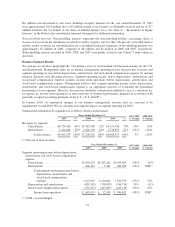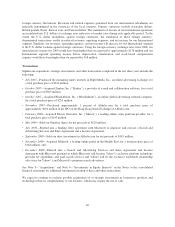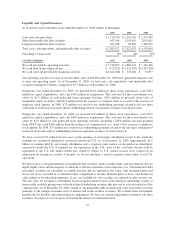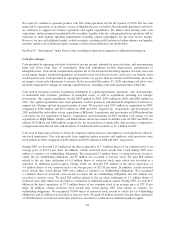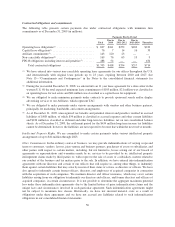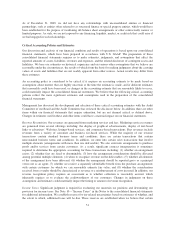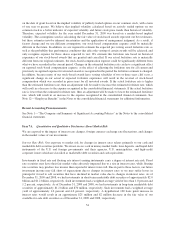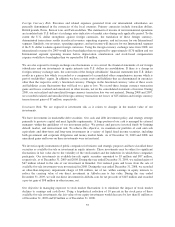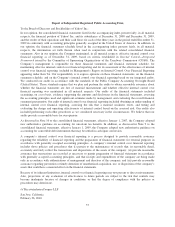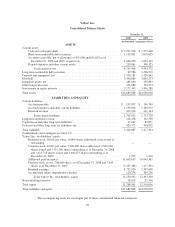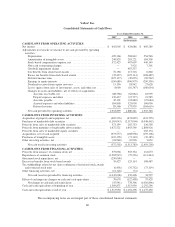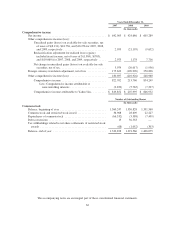Yahoo 2009 Annual Report Download - page 60
Download and view the complete annual report
Please find page 60 of the 2009 Yahoo annual report below. You can navigate through the pages in the report by either clicking on the pages listed below, or by using the keyword search tool below to find specific information within the annual report.positions might be challenged despite our belief that our tax return positions are in accordance with applicable
tax laws. We adjust these reserves in light of changing facts and circumstances, such as the closing of a tax audit,
new tax legislation, or the change of an estimate based on new information. To the extent that the final tax
outcome of these matters is different than the amounts recorded, such differences will affect the provision for
income taxes in the period in which such determination is made. The provision for income taxes includes the
effect of reserve provisions and changes to reserves that are considered appropriate, as well as the related net
interest and penalties.
We record a valuation allowance against certain of our deferred income tax assets if it is more likely than not that
those assets will not be realized. In evaluating our ability to realize our deferred income tax assets we consider all
available positive and negative evidence, including our operating results, ongoing tax planning, and forecasts of
future taxable income on a jurisdiction by jurisdiction basis. In the event we were to determine that we would be
able to realize these deferred income tax assets in the future, we would make an adjustment to the valuation
allowance, which would reduce the provision for income taxes.
Goodwill. Goodwill is not amortized, but is tested for impairment on an annual basis and between annual tests in
certain circumstances. The performance of the goodwill impairment test involves a two-step process. The first
step involves comparing the fair value of our reporting units to their carrying values, including goodwill. If the
carrying value of the reporting unit exceeds its fair value, the second step of the test is performed by comparing
the carrying value of the goodwill in the reporting unit to its implied fair value. An impairment charge is
recognized for the excess of the carrying value of goodwill over its implied fair value.
Our reporting units are based on geography, either at the operating segment level or one level below operating
segments. The fair values of our reporting units are estimated using an average of a market approach and an
income approach as this combination is deemed to be the most indicative of our fair value in an orderly
transaction between market participants and is consistent with the methodology used for the goodwill impairment
test in the prior year. In addition, we ensure that the fair values estimated under these two approaches are
consistent with each other. Under the market approach, we utilize publicly-traded comparable company
information to determine revenue and earnings multiples that are used to value our reporting units adjusted for an
estimated control premium. Under the income approach, we determine fair value based on estimated future cash
flows of each reporting unit discounted by an estimated weighted-average cost of capital, reflecting the overall
level of inherent risk of a reporting unit and the rate of return an outside investor would expect to earn.
Determining the fair value of a reporting unit is judgmental in nature and requires the use of significant estimates
and assumptions, including selection of market comparables, estimated future cash flows, and discount rates.
These components are discussed below:
•Market comparables
We select comparable companies in the specific regions in which our reporting units operate based on
similarity of type of business, primarily those involved in online advertising, and relative size of those
companies compared to our reporting units. Trailing and forward revenue and earnings multiples derived from
these comparable companies are applied to financial metrics of each reporting unit to determine their estimated
fair values.
•Estimated future cash flows
We base cash flow projections for each reporting unit using a five-year forecast of cash flows and a terminal
value based on the Perpetuity Growth Model. The five-year forecast and related assumptions were derived
from the most recent annual financial forecast for which the planning process commenced in our fourth
quarter. Key assumptions in estimating future cash flows include, among other items, revenue and operating
expense growth rates, terminal value growth rate, and capital expenditure and working capital levels.
Significant management judgment is involved in determining these assumptions.
52




